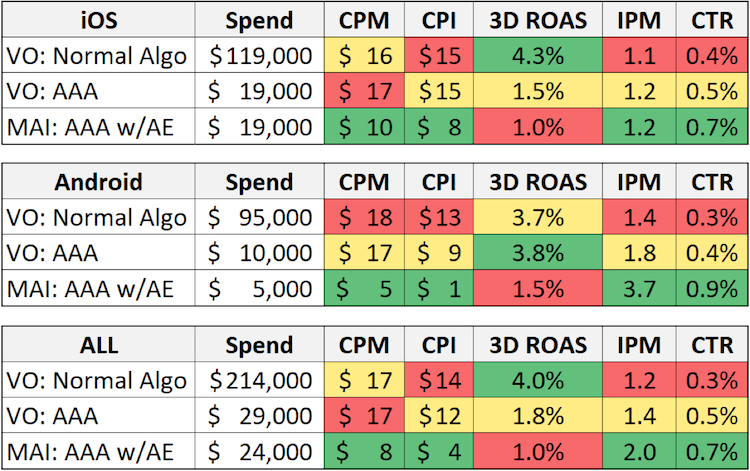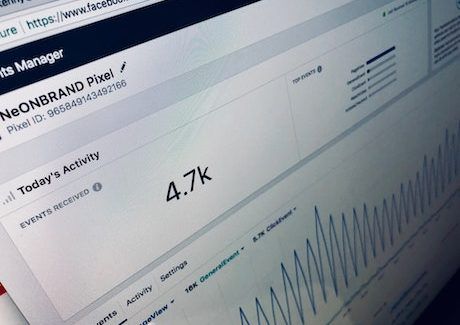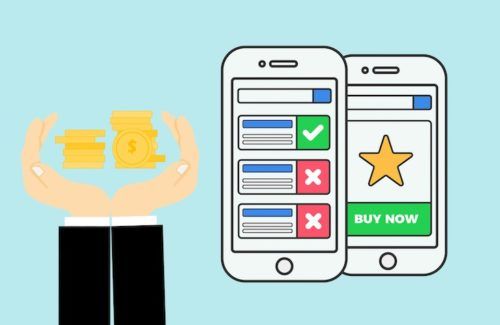Full-scale advertising automation is here for mobile apps. With Google’s AC (App Campaigns) now a necessary and substantial part of most paid acquisition strategies, is this the long-heralded end of active user acquisition (UA) management and the beginning of a low-touch portfolio management model?
Well no, not exactly. The full rollout of Facebook’s Automated App Ads (AAA) product actually represents an opportunity for buyers savvy enough to develop a successful strategy early in its life. Unlike Google’s AC, for now, Facebook’s standard auction buying still exists and can thrive alongside AAA campaigns. Formulating a tandem strategy for AAA and standard “business as usual” campaigns is key for 2020 and 2021, with several important layers to consider.
Building a focused campaign structure within your Facebook non-AAA traffic alongside evergreen AAA campaigns will ensure maximum scalability in the near future of fewer allowable ads and IDFA obsolescence. Think of AAA as a “helper” – a second UA manager running light-touch campaigns to your top identified geos and creative. There are three considerations to building a successful tandem strategy: high-confidence geo bundles, a data-driven creative testing process, and a future-proofed approach to ad/campaign limits with multiple regional Facebook pages for your app.
Geo-Strategy
AAA is unique in that only one campaign may be used for each optimization type and geo. What this means is that if you have a AAA Value campaign running to the UK, Canada, and Australia, you cannot also have a Value campaign running to Canada only.
Instead, utilize the flexibility of standard campaigns to test optimization/geo combinations with small budgets. Does Brazil monetize best with App Event Optimization (AEO) purchase or Level Achieved? Or is Brazil better suited as a cluster with other Portuguese countries or combined with a South American group? Identifying the best path to monetization requires having your tiered geo framework known in advance of AAA launch.
Most app developers will have already identified high-LTV countries, with some geos like the US and Canada warranting their own dedicated AAA campaigns for each platform. Test AAA in these dedicated country campaigns first with multiple optimization types being prioritized in a down funnel sequenced test.
As an example, your first six weeks of AAA might be:
- Week 1: AAA US Install + AEO purchase
- Week 2: AAA US AEO Registration
- Weeks 3-4: AAA US AEO purchase
- Weeks 5-6: AAA US Value (only applicable with iOS 14 + IDFA)
Based on the data below, you will see that for some apps, Facebook’s Ads Manager algorithm (normal algorithm) currently outperforms AAA. As such, take a dual approach of using both algorithms as they continue to evolve. Bearing in mind that AAA campaigns typically have a learning phase period in the first week, you will want to be patient while moving down the funnel when killing the previous campaign.
Facebook’s Ads Manager algorithm vs. Automated App Ads (AAA)
The separation point for geo-bundles comes with tier 2 and ‘rest of world’. While AAA in the US / tier 1 is being tested, consider aggressively testing tier 2 geo groups organized by top languages with Dynamic Language Optimization (DLO) so that you’re ready for AAA expansion. Post-AAA activation, standard campaigns will continue to exist as a sandbox for creative testing. Scale AAA to the top tier ‘rest of world’ and allow for your mature standard campaigns to complement AAA, graduating creative winners that emerge into the AAA mix.
Creative Testing
Unlike Google’s AC, the text / video / image inclusion cannot be broken into separate ad groups to measure and organize the effectiveness of creative concept types. The method is fill and pray: 50 videos / images with 10 text assets are set loose to give the Facebook AAA algorithm full control to determine spend allocation. While Facebook’s initial recommendation is to load up your campaign with the max number of assets, using your standard campaigns to isolate creative winners first will avoid wasted spend against concepts that fall flat. Identify 20 resonant videos and a handful of images before moving headlong into AAA.
🔍 Master Onboarding with JTBD & MaxDiff
Discover how to optimize your app’s onboarding process using the Jobs-to-be-Done framework and MaxDiff analysis.
Download nowTime to Prepare
You’ll also want to be planning for the long-term with our tandem approach. Other waves are on the horizon in the tide of consolidation:
- Facebook ad limits will soon be imposed by iOS14.
- Facebook’s coming ad limits will take effect in February. You can compare Facebook’s old advertising limits with Facebook’s new advertising limits (targeted to launch February 16, 2021) to get a better understanding of what to expect.
- Prepare now for Facebook Ad Limits in a sustainable way where you will not compete with yourself in the auction and bid yourself up.
-
- Perhaps the most curious workaround so far for ad limits is Facebook page proliferation. The limit lives at the page level and so setting up separate pages for each key geo group (App Main – US, App Main – Japan, etc.) is a clever way to expand your ad limit number without running into the platform limitations. You will want the additional flexibility the page hack provides to maintain the creative testing pace in standard campaigns. Consider breaking your Facebook page into multiple pages where the traffic is unique and will not compete:
- Primary post-iOS 14 traffic
-
- 1a: post-iOS14 + US only
- 1b: post-iOS14 + CA, UK, NZ only, etc.
-
- Pre-iOS 14 traffic
- Primary Android Page
-
- Android + US only
- Android + (CA, UK, NZ only), etc.
-
- Facebook Advertisers Should Prepare for iOS 14
- Estimated iOS 14 Adoption Rates: assuming Feb 1, 2021 launch
- 50% 30 days post launch
- 70% 120 days post launch
- 90% 180 days post launch > Assume August 2021 nearly 100%
- Facebook Suggested Actions To Take Now:
- Update to the latest Facebook SDK. Although it’s not required for advertisers to run app ads on iOS 14.0, they recommend as a best practice that you update to the newest version of the Facebook SDK to integrate the latest features and performance improvements. Version 8.0 is expected to be released in the coming weeks.
- Update to the latest Audience Network SDK (v 6.1) when it is released (expected in October). While this update is not required in order for advertisers to run app ads on iOS 14.0, updating will ensure they have the latest SDK features and performance improvements.
- If you work with a Mobile Measurement Partner (MMP), we recommend you check in with your MMP on specific requirements you may have to run app ads on iOS 14.0.
- Estimated iOS 14 Adoption Rates: assuming Feb 1, 2021 launch
Plan now, this Fall, with lean testing through standard campaigns to build a stable of winning videos, images, and copy messaging, tied to a wide variety of geo bundles. Grouping countries by LTV and behavior remains best practice, and preference given to larger country sets, in preparation for limited campaign count on iOS.
As always, the two rules of app marketing remain unchanged. Know your product and Know your users. Tailor a tandem AAA/standard campaign strategy based on existing user data from live campaigns and chart the unknowns with extensive testing. The time for thoughtful AAA/human campaign integration is now.














